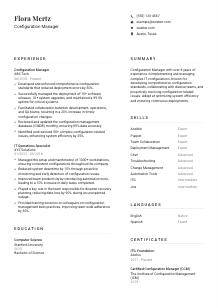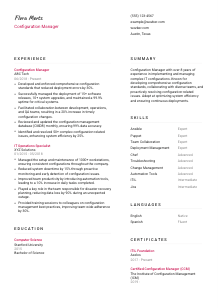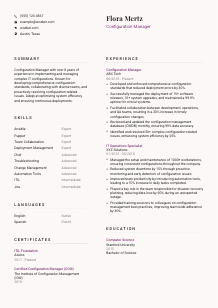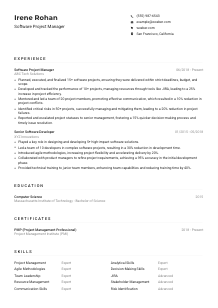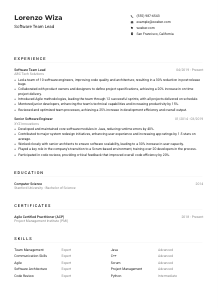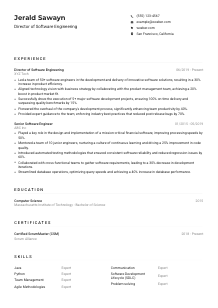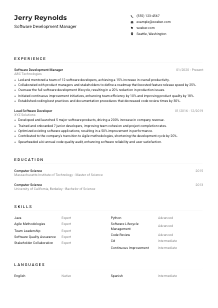Configuration Manager Resume Example
Tweaking settings, but your resume feels off? Refine your fit with this Configuration Manager resume example, structured using Wozber free resume builder. Grasp how you can thread your deployment skills through job requirements, configuring your career for optimal productivity and success!
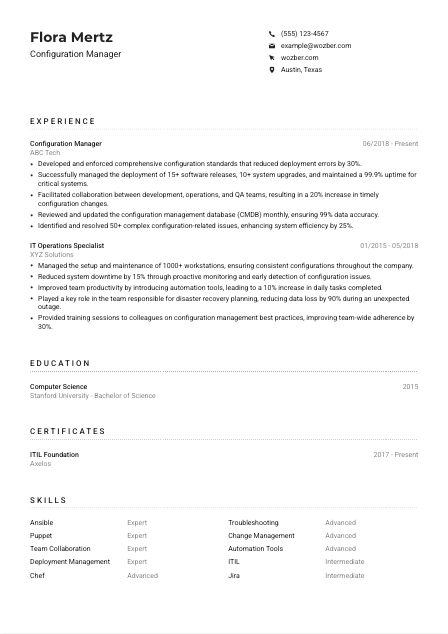
How to write a Configuration Manager resume?
Hello, future Configuration Manager! In a world where technology architectures evolve by the minute, your role is pivotal. Crafting a resume that showcases your mastery over systems and deployments is not just an advantage—it's essential. With Wozber's guidance, your journey begins. We're going behind the scenes, revealing how to align your resume perfectly with your dream job. Get ready to build a resume that not just talks the tech language but speaks directly to the hearts of recruiters.
Personal Details
The top of your resume is your digital handshake. For a Configuration Manager, this means setting up the stage for an impeccable first impression. Let's ensure that your introduction is not just professional, but configured to grab attention.
1. Your Name in the Limelight
Ensure your name is boldly and clearly displayed. This is your personal brand; make sure it's unmissable.
2. Job Title Precision
Right beneath your name, align with the job title from the description. For instance, "Configuration Manager" immediately signals your career focus to the hiring manager.
3. Contact Essentials
- Phone Number: This should be your number-one line for communication. Accuracy is key.
- Professional Email: Keep it simple with a format like firstname.lastname@email.com. Your email says a lot about your professionalism.
4. Geo-Targeting
"Must be located in Austin, Texas." Matching this requirement? Highlight Austin, Texas, in your contact details. It reassures the employer about your readiness and availability.
5. Website or Profile
Including a LinkedIn profile or personal portfolio website can strengthen your first impression. Ensure it's streamlined and professional, mirroring the precision of a well-configured system.
Takeaway
These steps are your blueprint for setting up an introduction that resonates. Think of it as configuring the settings before a major software rollout. Precision, clarity, and alignment with requirements are your best tools. Let's bootstrap your journey with confidence!





Experience
Within the mosaic of your resume, the experience section shines the brightest. As a Configuration Manager, this is your domain to showcase how you've orchestrated technology to work harmoniously. Let's dive deep into aligning your experience with the role at hand.
- Developed and enforced comprehensive configuration standards that reduced deployment errors by 30%.
- Successfully managed the deployment of 15+ software releases, 10+ system upgrades, and maintained a 99.9% uptime for critical systems.
- Facilitated collaboration between development, operations, and QA teams, resulting in a 20% increase in timely configuration changes.
- Reviewed and updated the configuration management database (CMDB) monthly, ensuring 99% data accuracy.
- Identified and resolved 50+ complex configuration‑related issues, enhancing system efficiency by 25%.
- Managed the setup and maintenance of 1000+ workstations, ensuring consistent configurations throughout the company.
- Reduced system downtime by 15% through proactive monitoring and early detection of configuration issues.
- Improved team productivity by introducing automation tools, leading to a 10% increase in daily tasks completed.
- Played a key role in the team responsible for disaster recovery planning, reducing data loss by 90% during an unexpected outage.
- Provided training sessions to colleagues on configuration management best practices, improving team‑wide adherence by 30%.
1. Highlighting Relevant Roles
Start by analyzing the job requirements. For each role you list, ensure it echoes the core responsibilities and skills demanded. For our guiding example, roles featured 'Developed and enforced comprehensive configuration standards,' perfectly matching the job's call for developing and maintaining configuration standards.
2. Company and Duration Clarity
Clearly state each company name and your period of employment. This transparency builds trust and outlines your journey's timeline.
3. Achievement-Focused Bullet Points
Phrase your contributions in terms of achievements. 'Successfully managed the deployment of 15+ software releases, 10+ system upgrades' showcases your proactive approach and success in crucial responsibilities.
4. Quantifying Your Impact
Whenever possible, anchor your achievements in numbers. 'Enhancing system efficiency by 25%' offers a tangible snapshot of your capability to elevate operations.
5. Relate and Streamline
Keep every point relatable to the Configuration Manager role. Extraneous information dilutes your expertise. Focus on your mastery over tools like Ansible, Puppet, and Chef, as these are directly relevant and sought-after skills in the job description.
Takeaway
Your experience section should narrate your career journey with effectiveness and efficiency in mind. It's about showcasing your roles align perfectly with what your future employer is seeking. Reflect, align, and configure your experiences to demonstrate your unparalleled fit for the Configuration Manager role.
Education
Your education is the foundation upon which your career is built. In a field as technical as Configuration Management, detailing your academic journey with precision is crucial. Let's align your educational qualifications with the heart of what makes a Configuration Manager successful.
1. Meeting Educational Requirements
The job asks for 'Bachelor's degree in Computer Science, Information Systems, or a related field.' If your degree matches, highlight it prominently. For example, 'Bachelor of Science in Computer Science' directly resonates with the job's primary educational criteria.
2. Concise and Clear Format
Your educational section should be a beacon of clarity. List your degree, the institution, and your graduation year in a straightforward manner.
3. Degree Alignment
Tailor your degree details to echo the job description perfectly. The synergy between your degree and the role's requirements establishes a strong foundation of relevance.
4. Coursework Highlights
If particular courses you've taken are highly relevant to the Configuration Manager role, don't hesitate to list them. Though our guide example didn't require this, it's a useful strategy when aligning with highly specialized roles.
5. Additional Educational Wins
Further academic achievements can bolster your resume. While senior roles might lean less on these, they're valuable when relevant to the tech world or demonstrating leadership and initiative, which are always in demand.
Takeaway
Think of your education section as the BIOS of your resume—it's fundamental to your professional output. Configure it with the care you'd apply to a critical system setup, ensuring every detail aligns with the requirements and aspirations of a Configuration Manager.
Certificates
In the ever-evolving tech landscape, continuous learning and certification are your armory. Especially for a Configuration Manager, certifications can underline your dedication and expertise. Let's navigate how to illuminate your resume with the gleam of your achievements.
1. Pinpoint Desirable Certifications
The job description mentions 'Certification in ITIL or equivalent IT service management framework is a plus.' If you've earned these, they should be proudly displayed. For example, 'ITIL Foundation', directly matches the optional qualifications, instantly elevating your resume.
2. Choose Quality Over Quantity
Listing certificates that directly reflect the job's needs speaks volumes. It's about showing the hiring manager you're not just qualified, but you're committed to excellence in your field.
3. Clarity on Dates
If the certification has a validity period or is particularly recent, adding the completion date showcases your dedication to staying current.
4. Continuous Improvement
In a role as dynamic as Configuration Management, the learning never stops. Keep adding to your certifications, focusing on new technologies and methodologies that enhance your capabilities.
Takeaway
Your certifications aren't just accolades; they're proof of your continuous journey towards excellence. Methodically select and present them as a testament to your commitment to staying at the forefront of Configuration Management. Let each certificate narrate a part of your story.
Skills
In the toolkit of a Configuration Manager, skills are the most versatile and dynamic elements. This section can truly differentiate you, painting a picture of a professional who's not just competent but compelling. Let's align your skills with precision, ensuring they resonate with the job at hand.
1. Extracting Key Skills
Scrutinize the job description for both explicit and implied skills. Technical proficiencies in tools like Ansible, Puppet, and Chef, mentioned in our guide example, are undeniably crucial. But don't overlook the implicit—your ability to troubleshoot complex IT systems, for instance.
2. Prioritizing Pertinent Skills
List your skills in a way that mirrors the job's demands. Rank them from your strongest down, ensuring that each one adds value and conveys your fit for the role.
3. A Clean Layout
Overloading with every skill you possess can dilute your message. Keep it focused and relevant, ensuring each skill you list is a piece of the puzzle that completes the picture of an exceptional Configuration Manager.
Takeaway
Your skills section is your strategic advantage, a direct communication channel to the hiring manager. Craft it with the intention to not just match but exceed the expectations. Let it be a declaration of your readiness and fluidity in the realm of Configuration Management.
Languages
In today's global IT environment, the ability to communicate across languages is a valuable asset. For a Configuration Manager, it can signify the ability to liaise with international teams or deal with global deployments. Let's make sure your linguistic skills augment your professional profile.
1. Matching Job Language Requirements
Starting with the basics, the job description requires 'high proficiency in English.' Highlight your native or fluent language skills up front, especially if it matches the job's primary language requirement.
2. Showcasing Additional Languages
Beyond English, if you're conversant in other languages, list them. Each additional language is a marker of your ability to operate in a globalized work environment, expanding your appeal.
3. Honest Proficiency Ratings
Clearly demarcate your comfort level with each language. Be truthful—misrepresentation could lead to awkward situations. Native, Fluent, Intermediate, or Basic are clear markers that give an honest account of your abilities.
4. Understanding the Role's Scope
For roles with an international dimension or those that involve liaising with global teams, linguistic skills can significantly bolster your application. Even if the job doesn't explicitly demand it, showcasing languages can set you apart.
5. Speaking a Global Language
Remember, each language you speak is more than a line on a resume—it signifies a bridge to another culture, another way of thinking. It's an invaluable asset in today's interconnected world.
Takeaway
Languages offer a window to the world. In your resume, let them serve as testament to not only your communication skills but also your versatility and adaptability. Your ability to engage in multiple languages could be the subtle nudge that sets you apart.
Summary
Your professional summary is the grand overview, the narrative that knits together your skills, experience, and aspirations. For a Configuration Manager looking to make an impact, this is your moment to shine. Let's embody the essence of the role, setting the tone for everything that follows.
1. Capturing the Job's Core
Examine the job description closely. Your summary should reflect your understanding and your capacity to fill the role. Begin with a statement that positions you strongly within the field. For example, our guide starts with "Configuration Manager with over 8 years of experience...", resonating immediately with the role's demands.
2. Launching with Your Story
Introduce your professional persona by linking your major strengths and experiences. Highlight your prowess in areas directly relevant to the Configuration Manager's responsibilities.
3. Addressing Key Qualifications
Identify and weave in qualifications from the job description that match your skills and achievements. This tailored approach speaks volumes about your fit for the role.
4. Keeping It Concise and Powerful
Your summary should be a high-impact pitch. It's your elevator speech on paper—aim for 3-5 compelling lines that encapsulate your qualifications and enthusiasm for the position.
Takeaway
Your professional summary is more than an introduction—it's your career narrated with precision, passion, and purpose. It's the handshake before the conversation, setting the stage for your resume to shine. Make it count.
Championing Your Configuration Manager Journey
Everything's configured: your career background, education, certifications, skills, and your professional summary. With these elements fine-tuned, your resume is no longer just a document—it's a beacon of your professional identity and potential. Wozber is here to ensure that this journey isn't just about landing a job, but about aligning your passion and expertise with the right opportunity. Your diligence in crafting a resume that speaks directly to the job at hand is the first step towards a future where technology isn't just managed—it's mastered.
Let Wozber's free resume builder, including the ATS-friendly resume template and ATS optimization tools, be your guide. Ready, set, deploy!

- Bachelor's degree in Computer Science, Information Systems, or a related field.
- Minimum of 5 years' experience in configuration management or related IT role.
- Strong proficiency with configuration management tools such as Ansible, Puppet, or Chef.
- Ability to understand and troubleshoot complex IT systems.
- Certification in ITIL or equivalent IT service management framework is a plus.
- The role demands high proficiency in English.
- Must be located in Austin, Texas.
- Develop and maintain configuration standards for software and hardware deployments.
- Manage the deployment and maintenance of software releases and system upgrades.
- Collaborate with cross-functional teams to ensure timely and accurate configuration changes.
- Regularly review and ensure accuracy of configuration management database (CMDB) and change management records.
- Proactively identify and resolve configuration-related issues to enhance system efficiency and availability.





